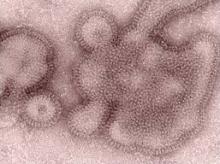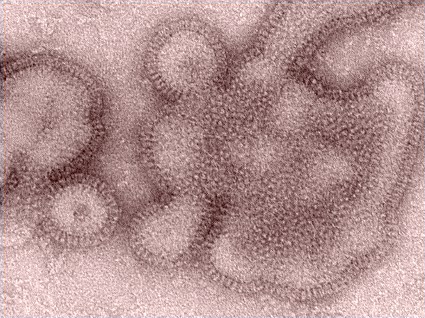User login
The ability to detect the recently circulating influenza variant H3N2v was low in some commercially available rapid detection tests, according to an analysis conducted by the Centers for Disease Control and Prevention.
"The ability to detect H3N2v virus varied substantially among the tests. This evaluation emphasizes the fact that a negative [rapid influenza detection test (RIDT)] result should not be considered as conclusive evidence of lack of infection with influenza A (H3N2)v ... Results from RIDTs, both positive and negative, always should be interpreted in the broader context of the circulating influenza strains present in the area, level of clinical suspicion, severity of illness, and risk for complications in a patient with suspected infection," the CDC said Aug. 10 in an early online release from Morbidity and Mortality Weekly Report (2012;61:1-3).
The H3N2v viruses can be definitively identified only at qualified U.S. public health laboratories using a polymerase chain reaction–based influenza diagnostic panel that is not available as a point-of-care test for clinicians. Specimens that test positive for influenza A, H3, and pandemic influenza A markers and negative for H1 and pandemic H1 markers are called "presumptive positive for influenza A(H3N2)v virus," until confirmed as influenza A(H3N2)v, the CDC said.
The CDC analyzed seven Food and Drug Administration–cleared rapid influenza detection tests (RIDTs) for their ability to detect H3N2v viruses, of which 153 infections were reported from four states between July 12 and Aug. 9, 2012. Each of the seven RIDTs – the BinaxNOW, Directigen, FluAlert, QuickVue, Sofia, Xpect, and Veritor – was tested with seven different H3N2 viruses, according to their respective package instructions. Positive and negative controls contained in each RIDT were run before testing the viruses in the study to verify performance of each assay lot, with the exception of FluAlert, which does not provide controls.
Only four of the seven RIDTs (Directigen, Sofia, Veritor, and Xpect) detected all influenza A(H3N2)v viruses. BinaxNOW detected five of seven, and QuickVue detected three of seven. FluAlert detected only one of seven, the CDC said.
More data are needed on the clinical performance of all RIDTs in detecting H3N2v virus in various respiratory specimens, the CDC said.
Clinicians should minimize the occurrence of false RIDT results by strictly following the manufacturer’s instructions, collecting specimens soon after the onset of influenza-like illness – ideally within the first 72 hours – and confirming RIDT results by sending the specimen to a public health laboratory. Additional CDC guidance on interpretation of RIDTs for testing of patients with suspected H3N2v infection is available here.
No disclosure statement was listed.
The ability to detect the recently circulating influenza variant H3N2v was low in some commercially available rapid detection tests, according to an analysis conducted by the Centers for Disease Control and Prevention.
"The ability to detect H3N2v virus varied substantially among the tests. This evaluation emphasizes the fact that a negative [rapid influenza detection test (RIDT)] result should not be considered as conclusive evidence of lack of infection with influenza A (H3N2)v ... Results from RIDTs, both positive and negative, always should be interpreted in the broader context of the circulating influenza strains present in the area, level of clinical suspicion, severity of illness, and risk for complications in a patient with suspected infection," the CDC said Aug. 10 in an early online release from Morbidity and Mortality Weekly Report (2012;61:1-3).
The H3N2v viruses can be definitively identified only at qualified U.S. public health laboratories using a polymerase chain reaction–based influenza diagnostic panel that is not available as a point-of-care test for clinicians. Specimens that test positive for influenza A, H3, and pandemic influenza A markers and negative for H1 and pandemic H1 markers are called "presumptive positive for influenza A(H3N2)v virus," until confirmed as influenza A(H3N2)v, the CDC said.
The CDC analyzed seven Food and Drug Administration–cleared rapid influenza detection tests (RIDTs) for their ability to detect H3N2v viruses, of which 153 infections were reported from four states between July 12 and Aug. 9, 2012. Each of the seven RIDTs – the BinaxNOW, Directigen, FluAlert, QuickVue, Sofia, Xpect, and Veritor – was tested with seven different H3N2 viruses, according to their respective package instructions. Positive and negative controls contained in each RIDT were run before testing the viruses in the study to verify performance of each assay lot, with the exception of FluAlert, which does not provide controls.
Only four of the seven RIDTs (Directigen, Sofia, Veritor, and Xpect) detected all influenza A(H3N2)v viruses. BinaxNOW detected five of seven, and QuickVue detected three of seven. FluAlert detected only one of seven, the CDC said.
More data are needed on the clinical performance of all RIDTs in detecting H3N2v virus in various respiratory specimens, the CDC said.
Clinicians should minimize the occurrence of false RIDT results by strictly following the manufacturer’s instructions, collecting specimens soon after the onset of influenza-like illness – ideally within the first 72 hours – and confirming RIDT results by sending the specimen to a public health laboratory. Additional CDC guidance on interpretation of RIDTs for testing of patients with suspected H3N2v infection is available here.
No disclosure statement was listed.
The ability to detect the recently circulating influenza variant H3N2v was low in some commercially available rapid detection tests, according to an analysis conducted by the Centers for Disease Control and Prevention.
"The ability to detect H3N2v virus varied substantially among the tests. This evaluation emphasizes the fact that a negative [rapid influenza detection test (RIDT)] result should not be considered as conclusive evidence of lack of infection with influenza A (H3N2)v ... Results from RIDTs, both positive and negative, always should be interpreted in the broader context of the circulating influenza strains present in the area, level of clinical suspicion, severity of illness, and risk for complications in a patient with suspected infection," the CDC said Aug. 10 in an early online release from Morbidity and Mortality Weekly Report (2012;61:1-3).
The H3N2v viruses can be definitively identified only at qualified U.S. public health laboratories using a polymerase chain reaction–based influenza diagnostic panel that is not available as a point-of-care test for clinicians. Specimens that test positive for influenza A, H3, and pandemic influenza A markers and negative for H1 and pandemic H1 markers are called "presumptive positive for influenza A(H3N2)v virus," until confirmed as influenza A(H3N2)v, the CDC said.
The CDC analyzed seven Food and Drug Administration–cleared rapid influenza detection tests (RIDTs) for their ability to detect H3N2v viruses, of which 153 infections were reported from four states between July 12 and Aug. 9, 2012. Each of the seven RIDTs – the BinaxNOW, Directigen, FluAlert, QuickVue, Sofia, Xpect, and Veritor – was tested with seven different H3N2 viruses, according to their respective package instructions. Positive and negative controls contained in each RIDT were run before testing the viruses in the study to verify performance of each assay lot, with the exception of FluAlert, which does not provide controls.
Only four of the seven RIDTs (Directigen, Sofia, Veritor, and Xpect) detected all influenza A(H3N2)v viruses. BinaxNOW detected five of seven, and QuickVue detected three of seven. FluAlert detected only one of seven, the CDC said.
More data are needed on the clinical performance of all RIDTs in detecting H3N2v virus in various respiratory specimens, the CDC said.
Clinicians should minimize the occurrence of false RIDT results by strictly following the manufacturer’s instructions, collecting specimens soon after the onset of influenza-like illness – ideally within the first 72 hours – and confirming RIDT results by sending the specimen to a public health laboratory. Additional CDC guidance on interpretation of RIDTs for testing of patients with suspected H3N2v infection is available here.
No disclosure statement was listed.
FROM MORBIDITY AND MORTALITY WEEKLY REPORT

